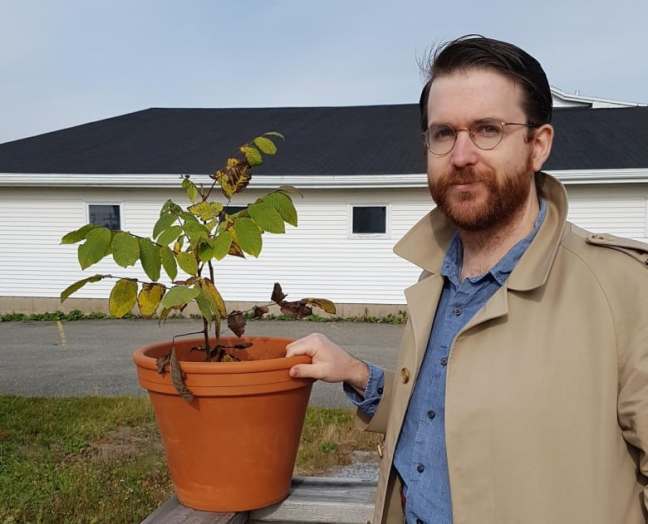
An amateur historian believes an endangered New Brunswick tree species strongly indicates that Vikings once visited the province.
The butternut tree is found along the lower St. John River Valley and was once quite bountiful before over-harvesting.
This tree is found in New Brunswick, but not in Newfoundland.
At L’Anse aux Meadows, the only confirmed Viking site in Canada, located in Newfoundland and Labrador, there is evidence of butternut tree logs. The logs were cut with European tools, which would seem to rule out their importation by Indigenous people.
The presence of foreign logs cut by European tools near a Viking settlement makes Tim McLaughlin, secretary of the New Brunswick Historical Society, believe that Vikings harvested the logs in New Brunswick.
“It’s a suggestion, a very strong suggestion that the Norse, or the Vikings, went well beyond L’Anse-aux-Meadows a thousand years ago,” said Tim McLaughlin, secretary of the New Brunswick Historical Society.
The theory is gaining some traction, with Parks Canada’s senior archeologist emerita Birgitta Wallace telling CBC News in 2018 that she believes Vikings did visit the province.
The sagas
The Norse sagas, semi-factual stories about the Vikings, talk about a place called Vinland.
The sagas, written between 1200 and 1300, describe battles and travels that took place between the
9th and 11th centuries.
9th and 11th centuries.
Vinland is described as a paradise, with high tides and grapes and warmer than Greenland, which the Vikings also explored.

This can be used to describe areas in New Brunswick, McLaughlin said.
“They found wild grapes, they found big trees, they experienced extremely high tides, they encountered a lot of wildlife a lot of salmon and different fish, whales and so forth,” said McLaughlin.
“It was a relatively mild land compared to where they come from, Greenland, which is fairly inhospitable.”
Where in New Brunswick
According to McLaughlin, there are two areas in the province that people believe are Vinland: Miramichi and the Bay of Fundy coast.
Miramichi is, of course, closer to Newfoundland, and the Vikings would not have had to sail around the Maritimes to get there.

But McLaughlin thinks the Fundy coast is more likely, since butternut trees and grapes are more plentiful in southern New Brunswick.
“Just the descriptions of the landscape I tend to think that it accords more with the Bay of Fundy than Miramichi,” said McLaughlin.
Forgotten history?
While the province may have a legitimate claim to the title of Vinland, this isn’t really promoted.
McLaughlin said this is because there is no concrete artifacts or site that people can point to, such as L’Anse-aux-Meadows because Vinland wasn’t a place where the Vikings settled down.

“They didn’t build any permanent structures,” said McLaughlin.
“They built what they called booths, which were temporary structures, and they were really just here to gather resources. So it’s really not that surprising that we haven’t found anything in New Brunswick to connect it with Vineland.”
McLaughlin is hosting a talk about the province’s possible connections to the Vikings on Tuesday at the New Brunswick Museum in Saint John.
With files from Elke Semerad and Information Morning Saint John
The Vinland settlement's location is a fascinating mystery, and the butternuts' discovery at L'Anse aux Meadows are a strong clue as to where the Vikings sailed. In fact, the Vikings could technically have gotten these butternuts either by sailing southwest from Labrador to northeast New Brunswick, or by sailing south down Nova Scotia's east coast and then west to New Brunswick or New England.
ReplyDeleteA map of the locations of butternuts in Canada and the US is here:
historum.com/attachments/butternut-map-from-canadian-website-jpg.64821
The two Sagas describe a total of 4 Viking settlements or camps that must be different from and in addition to the Viking settlement found at L'Anse aux Meadows:
Settlement #1. Leif's Settlement in the Greenlander's Saga by a lagoon or salmon lake connected to the Gulf of St. Lawrence. Apparently it's on the southern half of the west coast of Newfoundland, or else the southern coast of the Gulf of St Lawrence that runs from western Cape Breton to northeastern New Brunswick.
Settlements #2-4 in Eric the REd's Saga.
#2: Straumsfjord,
#3: a cape between #2 and #4.
#4: Hop
Settlements #2-4 could be anywhere on the Atlantic coast stretching from L'Anse aux Meadows down the east coast of Newfoundland and the east coast of Nova Scotia, down south to NYC or even to the Carolinas. My sense is that #2: Straumsfjord would most likely be the Bay of Fundy, like the St. John's River Valley where butternuts grow wild.
I drew maps as to how those 4 sites would look if the Sagas' directions to them were taken literally here:
historum.com/t/where-do-the-viking-sagas-point-to-the-vikings-visiting-in-the-us-or-southeast-canada.196378/
forum.paradoxplaza.com/forum/threads/fun-puzzle-which-parts-of-canada-and-the-us-did-the-vikings-visit.1594399/#post-29069025
Good Luck and Happy Searching!